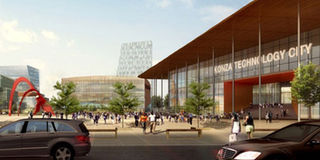Konza: The tale of techno city with diminishing returns

PHOTO | FILE An artist's impression of the Konza Technology City.
What you need to know:
- Across Mombasa Road, facing the Konza techno city, Zone C1, also known as Katheke Technoview, will be left to residential developments targeted at middle to upper income earners working within the technopolis.
- Alternatively, the government may acquire the land, re-plan it, and reallocate it,” said Institution of Surveyors of Kenya chairman Collins Kowuor.
Speculators who have bought land close to the planned Konza Technology City may be in for a rude shock as the government implements stringent physical planning guidelines for the area.
A local physical development plan for the 252km square buffer zone around the planned city has set minimum plot sizes that may restrict land owners from developing their property.
The plan, which was approved by the Ministry of Lands last December, is aimed at ensuring that shanties and unplanned developments do not mushroom near the planned techno city and dim its allure to investors.
“Uncontrolled and unplanned urbanisation is a threat to general development of the area and the proposed techno city,” reads part of the Konza technocity buffer zone development plan.
Physical planning guidelines set out in the document will be in force for 20 years, after which they may be reviewed to fit evolving needs. The Department of Physical Planning has divided the buffer area into three zones —A, B, and C— each with its own designated use as well as plot size limitations.
Although Zone C covers the smallest area in the buffer area, property developers in this region will be subjected to the most detailed regulations.
Across Mombasa Road, facing the Konza techno city, Zone C1, also known as Katheke Technoview, will be left to residential developments targeted at middle to upper income earners working within the technopolis.
Minimum plot sizes for homes and apartments will be 1.97 acres (0.8 hectares) and only part of this land can be built up, with the rest expected to be manicured.
This may prove a challenge to land owners, given that some speculators have divided plots into 1/8 acre pieces. To address this, the department proposes a strategy of “amalgamation, re-planning, and reorganisation of the subdivision (pooling and readjustment) into appropriate design”.
This may imply that the people who own many small plots will be required to amalgamate them and develop them into one large plot. Land owners may also come into agreements to provide property jointly.
Alternatively, the government may acquire the land, re-plan it, and reallocate it,” said Institution of Surveyors of Kenya chairman Collins Kowuor.
ASTRONOMICAL PRICES
Speculation on land around the 5,000-acre area set aside for the technopolis has gone a notch higher, leading to an astronomical rise in land prices.
Surveys carried out by the ministry indicate that land prices have risen by as much as 2,400 per cent since 2008, when the government acquired the property on which to build the city.
A restriction on further subdivision in Zone C2 (Malili Centre) and Zone C3 (Konza Town) has also been recommended.
Malili is an unplanned development that has cropped up close to the planned techno city while Konza Town is built near a railway station.
Due to its proximity to the railway station, Konza Town is set to become the region’s industrial area, hosting factories and housing for its workers as well as those who will spill over from the techno city.
About 42 per cent of the buffer area will be dedicated to the conservation of wildlife.
This area, designated as Zone A1 and Zone A2, covers ranches to the west and north east of the planned techno city.
Human settlement in this area will be highly controlled. Developments will be restricted to hotels, nature trails, and other tourist-geared businesses.
Zone B, which covers about 55 per cent of the buffer zone, will be left to commercial agriculture. The government plans to empower land owners in these regions with the technology needed to adopt modern farming techniques that will see the region, including Konza Techno City, become self-sufficient.
The buffer area falls across three counties: Kajiado, Makueni, and Machakos. The three counties have been urged to cooperate in managing the buffer area to ensure that contradictory policies are not put in place.
“A joint board, Konza City Management Board (KCMB), should be created to coordinate all the actors as indicated in the plan implementation matrix and enforce development contracts,” reads the plan.
Already, the counties are fighting over the location of the planned technopolis. In maps used by the Ministry of Lands and Planning, the buffer zone indicates that the techno city is in Machakos. However, Makueni has also laid claim to it. The respective governors are in talks to resolve the matter.
Once constructed, Konza City is expected to create thousands of jobs. Ukambani leaders have bemoaned the delays in the commencement of the project, citing lack of political will.




